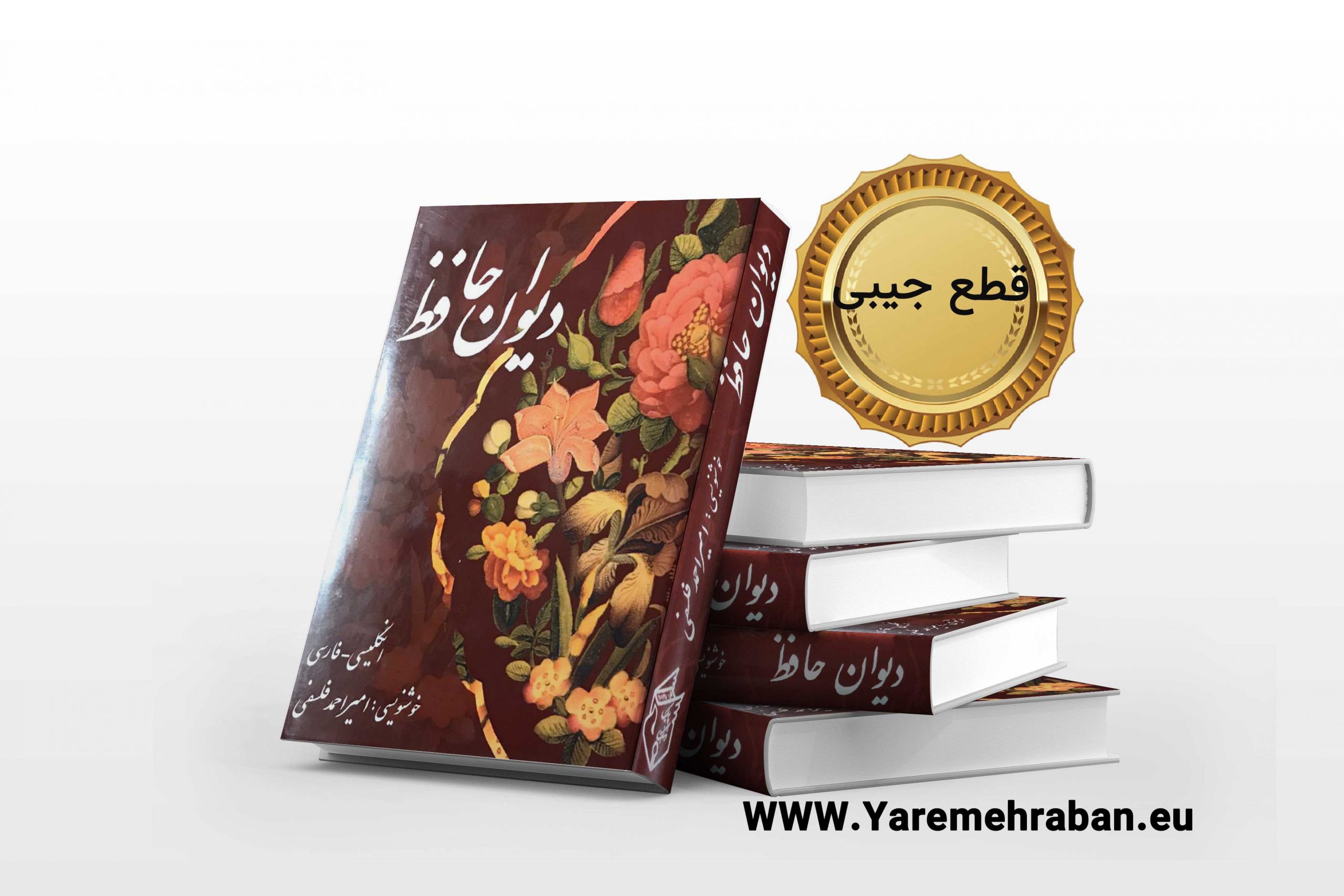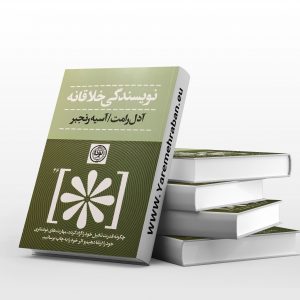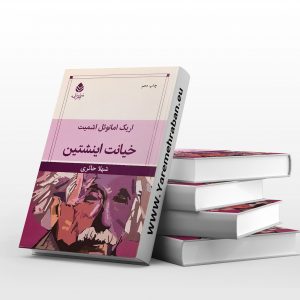Description
Introducing the book of Divan Hafez (pocket)
Divan of Khajeh Shamsuddin Mohammad Hafez Shirazi, a complete collection of poems and lyric poems of Hafez has been published. Ghazal of Hafez has romantic levels such as Ghazal of Saadi, has mystical levels of Ghazal of Attar, Rumi and Iraqi, and on the other hand has the main task of the ode which is praise.
Hence, Hafez’s poetry represents all three major currents of poetry before him, and the protagonist of his poetry is both a god and a lover and a praiser.
Hafez’s poetry in the vertical axis is mostly worldly and romantic or praiseworthy, and various themes such as mysticism are in the verbal axis, and those who consider his poetry as mystical pay attention to the horizontal axis, that is, they consider his verses independent.
There is no doubt that there is a delicate artistic connection between Hafez’s verses.
But it should be noted that the longitudinal connection with the unity of the subject is different and the connection of his verses with each other is sometimes through the association of words and meanings.
What separates his poetry from the poetry of the poets of the combined group, in addition to God-given grace, is that Hafez is also a political and militant poet, who has dealt with acute social issues of his time with the language of ambiguity and humor, and with the kind of pretending kings. And the ascetics and false Sufis have been engaged in fierce struggles, and therefore his poetry is full of historical references to the situation of his time, many of which are unknown to us.
On the other hand, he has snatched the lead from everyone in the use of literary language, that is, the full use of novelty and expression, and the creation of numerous musical and semantic relations between words.
In the literal novel, he pays more attention to the types of puns and rhymes, and in the spiritual novel, he pays more attention to the types of ambiguities such as the ambiguity of proportionality, the ambiguity of contradiction, the ambiguity of translation and exchange, and the ambiguity of puns and employment. His poetry is no longer empty of allusions to mystical and Qur’anic points and teachings.
Ambiguity in Hafez is noisy and its frequency is higher than all industries in a way that some have considered it as the main feature of Hafez style. The different types of ambiguity in Hafez’s poems are such that there is a view that Hafez discovered this industry for the first time.
Another major feature of Hafez’s poetry is humor, which he has used in all fields, including the imaginary, and sometimes recalls Khayyam in intellectual fields.
But in general, Hafez’s Divan is a summary of all the important currents and responsibilities of the literature before him. He paid attention to the poems of all the great poets, especially to the poems of his contemporaries, half of the poets of the ensemble, and many of his lyric poems are imitations of their lyric poems.
But his literary expression overshadows all the original examples.
Khajeh Shamsuddin Mohammad Shirazi, nicknamed “Hafiz”, is a great lyricist and one of the gods of Persian poetry and literature. He was born in Shiraz around 726 AH.
He learned science and technology in the class of the stars of the time and found a high foundation in the literary sciences of the time. Especially in jurisprudential and divine sciences, he pondered a lot and memorized the Qur’an with fourteen different narrations.
Goethe, the great German scientist, poet, and orator, wrote his Oriental Divan in his name, inspired by his thoughts. His collection of poems includes lyric poems, several poems, several Masnavi, pieces and quatrains. He died in 792 AH in Shiraz.
His tomb in the memory of Shiraz is a shrine of scholars and lovers of Persian poetry and literature.

Part of the text of Hafez’s book
Open the scent of Saba Zan’s navel’s eyes How much blood fell in the hearts from the swing of his black hair
How safe I am in Janan’s house, because every time Jaras shouts for you to take off your shoes
Gareth Pir Moghan tells the rug that the seeker was not unaware of the way of drawing houses.
Divan Hafez includes all the poems attributed to him that have been left by him. This book was first officially published between 1200 and 1206 AH.
The first person to collect Hafez’s poems was Mohammad Glandam. There has been a lot of encroachment on Hafez’s poems and we see that the number of poems is different in each version. The themes of the poems about the situation of their time are wisdom and mystical issues.
Hafez’s divan includes lyric poems, poems, Masnavi, pieces and quatrains.
Hafiz’s poems are very few and since some of his poems are similar to the sonnet in terms of structure, in some versions, the poems have been published in the number of sonnets.
Hafez’s main poems are related to his lyric poems, of which there are about 500 lyric poems in his divan. Regarding Masnavi, in some old versions, there are two Masnavi which show that Hazrat Hafez had a theoretical view of Weiss and Ramin, Iqbalnameh and Sharafnameh.
The other part is related to the pieces that Hafez composed to record historical events. These pieces are more important from a historical perspective, and the last part is related to the quatrains that are mostly seen in recent versions.
Hafez’s poems are the most familiar poems for the common people and properties, and this position may exist for few people in the world, and every year various meetings are held for Hafez studies in Iran and the world.
In any Iranian house, if there is a book of poetry, it is most likely Hafez’s divan.
Review of Hafez’s book
Ancient Iranian literature has poets whose works have not only not been forgotten and marginalized over the centuries, but are still fresh and pleasing.
Hafez is one of the greatest lyricists in Iran, whose book of poetry can be found in almost every house in Iran, and Hafez’s divination is an inseparable part of Iranian culture. On the other hand, Hafez and his ideas have many complexities and Hafez research is one of the important research fields in Iranian literature.
Many writers and thinkers have tried to re-read and correct Hafez’s works and to understand the depth of the thoughts of this unique lyricist.
Bahauddin Khorramshahi, one of the most prominent contemporary Iranian writers and editors, has also devoted much time to researching Hafez and his works and ideas.
The book of Hafez by Bahauddin Khorramshahi is one of the best examples of Hafez research in which Khorramshahi has tried to introduce Hafez better to his audience and increase the sweetness of his works for the interested reader.
About the author of Hafez’s Divan: Hafez Shirazi
Khajeh Shamsuddin Mohammad bin Bahauddin Mohammad Hafez Shirazi is a famous poet of the eighth century Iran. Also known as the tongue of the unseen, he is the most famous Iranian poet. Hafez’s divan, which is full of unique lyric poems, has perfumed the history of Iranian literature.
This famous Iranian poet, whose poems are sung in the East and the West, was born in 727 AH in Shiraz.
He was a baker as a teenager and his education was school. It is known that he has been studying knowledge and memorizing the Qur’an for various years for forty years. The title of Hafiz was also given to him because he knew the whole Qur’an from memorization.
Hafez’s lyric style is Iraqi, and many consider him to be influenced by the famous Iranian poet Khajavi Kermani. He died in 792 AH in his hometown.
Divan Hafez, an inseparable part of Iranian life
Divan Hafez is the most famous book of Iranian literature. Anyone who has a book at home in Iran probably also has a volume of Hafez. Few Iranians have ever opened Hafez and tried not to read it.
There are several manuscripts of this book. Many kings and nobles throughout history have tried to preserve the Divan of Hafez or have their own unique version.
Memories written on fine paper or with fine leather covers, many of which are very expensive. The most famous of these are the eighth-century manuscript in the Badlian Library of Oxford University, written by Alaa Marandi, and the Hagia Sophia, written by Hassan bin Nasrallah and housed in the Sulaymaniyah Library in Istanbul.
It is known that the first printed version of Hafez’s Divan belongs to the year 1200 AH in Kolkata, India.
Hafez’s Divan has been corrected many times. The most authoritative versions today are the correction of Allameh Qazvini and the correction of Dr. Ghani.
About Hafez’s book, a lasting work in Hafez studies
Hafez’s book is one of several Bah کتاب’u’ll .h Khorramshahi books about Hafez Shirazi. A new edition of this book has been published in 1987.
Hafez Divan has been published more than four hundred times in various forms and methods in Persian and other languages of the world, and in total, more than 1700 manuscripts of Hafez Divan have been known so far.
Instead of speed, Hafez was careful and worked on his sonnets and took at least a month for each one. Hafez scholars say that Hafez corrected each poem many times after composing it, and this has led to many copies and changes in his poem, so we can have several valid editions of Hafez’s divan.
1- Introducing the book on YouTube
2- Introducing the book in Aparat














Reviews
There are no reviews yet.